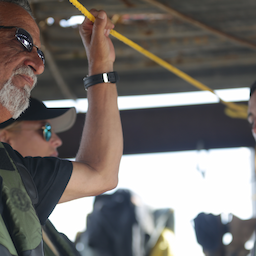The five-part documentary recounts the 1986 murder of Jennifer Levin at the hands of Robert Chambers.
“Before O.J. Simpson, the Preppy Killer was the trial of the century,” New York Post columnist Steve Dunleavy says in the new documentary, The Preppy Murder: Death in Central Park, which re-examines the 1986 murder of Jennifer Levin at the hands of Robert Chambers.
In the early hours of Aug. 26, a woman’s body was discovered in Central Park. It belonged to Levin, an 18-year-old about to start her freshman year of college who had been gruesomely strangled and left for dead by her assailant. “I have been to many, many, many homicides in my career… This was a gruesome, vicious homicide,” says Wally Zeins, who was a Detective Sergeant and the commanding officer of Manhattan detectives from midnight to eight in the morning at the time and the Hostage Supervisor for the whole city. When asked, he can still recount the vivid details of the crime scene just like it was today.
It didn’t take long for police to learn that she had been with Chambers the night before, making him their prime suspect. Once the 20-year-old had been identified, Zeins says that’s when the case became “bigger than a circus.” And what looked like an open-and-shut case soon started to unravel thanks to a string of bad luck in the investigation, some mistakes by law enforcement and a trial that took on a life of its own.
Chambers, the epitome of white privilege, youth and beauty, was able to use the press to his advantage -- he even appeared on the cover of New York magazine -- while Levin’s reputation was dragged through the mud. She was largely portrayed as a sexually promiscuous woman who “had it coming.” And when the jury became deadlocked, Chambers was able to plead guilty to a lesser charge of manslaughter and was only sentenced to five to 15 years in prison.
Thirty-three years later, the case is still a vivid memory for those who lived through it, including executive producer and CEO of Bungalow Media + Entertainment Robert Friedman, who grew up in New York City and used to hang out at Dorrian's -- the same bar where Chambers and Levin met -- as a teenager before going on to produce documentaries like The Panama Papers and the upcoming Surviving Jeffrey Epstein on Lifetime.
“People think that they know everything about this case,” Friedman tells ET. “But one of the important things is to discover new stuff.” And when it comes to this five-part series directed by Ricki Stern and Annie Sundberg (Joan Rivers: A Piece of Work), it’s about exposing a tale of America’s untamed ambition in the 1980s bolstered by the unchecked lifestyle of New York’s privileged prep school kids, sexism, elitism, a culture of victim-blaming, and an all-out media war that played out in the tabloids.
Restoring Jennifer Levin’s Memory
In the decades since, Chambers and Levin’s story has been turned into the 1989 TV movie The Preppie Murder starring William Baldwin and Lara Flynn Boyle, and has inspired multiple episodes of the Law & Order franchise as well as Mike Doyle’s character on the HBO series Oz and Illeana Douglas’ character in the Martin Scorcese film Cape Fear. The Preppy Murder docuseries, however, is the first of its kind to take an in-depth look at these true-crime events.
“What always was concerning to me was I never really got to look at the memory of Jennifer,” Friedman says, explaining why he wanted to tell this story from Levin’s point of view. “That whole case and in the many ways that it was reported, was an assault on her memory.”
“She came from a good family. She was a good person,” says Zeins, who, in addition to being one of the first on the scene, had to tell Levin’s family that she was dead. “I was glad to get involved in this project because I wanted the public to know that Jennifer was not the person that people told stories about in the media.”
In addition to Zeins, Levin’s memory is restored by her family and friends who provide detailed accounts of who she was as a person leading up to her murder. The documentary also takes advantage of the context added by the #MeToo movement and subsequent Time’s Up initiative. “I think it will help dispel the false narratives, not only of her life, but women’s lives in general,” Friedman says.
In Levin’s case, that’s exposing how Chambers’ high-profile defense portrayed the victim as “fast and loose” and how something like a day planner was turned into a sex diary. In actuality, it was nothing more than “a notebook that has friends' names and addresses in it,” says Zeins, who blames the media for “dragging her through the streets.”
“In the culture, women at that time were not allowed to talk about sex,” Friedman continues, adding that women were vilified for that kind of perceived behavior. “It’s really interesting that this process is real today as it was 25 years ago.”
What Happened to Robert Chambers
While wanting to tell Levin’s story, Friedman says the production did reach out to Chambers for an interview. “He did not want to participate, but we would have included him in the series,” he says.
In addition to exposing how Levin was portrayed at the time, the docuseries also looks at what happened to Chambers, who largely went unscathed during the trial. But according to Zeins, Chambers “was a callous individual.”
Zeins goes on to reveal that after Chambers’ arrest, his bail was posted by the owner of Dorrian’s because his son was a close friend of the suspect. (“They were very uncooperative,” the retired detective adds.) Chambers appeared on the cover of the Nov. 10, 1986 issue of New York Magazine, which depicted him as a confident, handsome young man -- “a legend among the younger private-school girls” -- and the product of wealth and privilege with a slight cocaine habit. During the trial, the Catholic Church was visibly present behind Chambers’ defense team and former cardinal-bishop Theodore McCarrick wrote a letter to the judge praising him as a devoted member of the church.
McCarrick, as the documentary points out, has since been laicized by the Vatican after he was found guilty of “solicitation in the Sacrament of Confession, and sins against the Sixth Commandment with minors and with adults, with the aggravating factor of the abuse of power.” While the film doesn’t jump to any conclusions, Friedman says this revelation certainly brings up a lot of questions about Chambers’ past.
In the end, Chambers was sentenced to five to 15 years in prison after striking a plea bargain to plead guilty to the lesser crime of manslaughter in the first degree and to one count of burglary. After serving his full sentence, he was released in 2003. Five years later, in 2008, Chambers pleaded guilty to selling drugs after various encounters with the law and was sent to 19 years in prison with his earliest release date possible being in 2024. The sentence was longer than the one he served for the murder of Levin.
“He's a complete dirtbag as far as I'm concerned,” says Zeins, who has no doubt that Chambers will end up back in prison again after his eventual release. When it comes to people watching the documentary, he “hopes they learn from her tragic death… the public will see a very different picture when they find out the real story about Robert Chambers.”
The Preppy Murder: Death in Central Park airs Wednesday, Nov. 13 through Friday, Nov. 15 at 9 p.m. ET on AMC and SundanceTV.
RELATED CONTENT:


